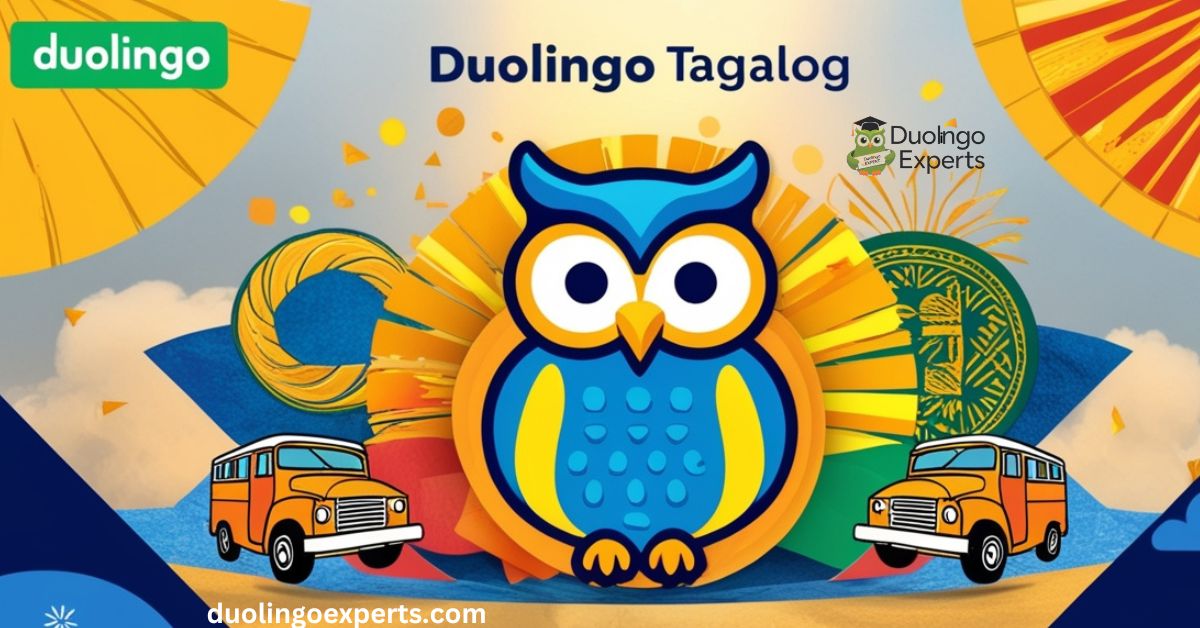Duolingo has become one of the most popular language-learning platforms in the world, offering courses in over 30 languages. However, one major language has been notably absent: Tagalog. Despite the growing interest in the Tagalog language and the large number of Tagalog speakers worldwide, Duolingo has not yet released a course for learners of this beautiful language.
If you’re looking to learn Tagalog and wondering why it’s not on Duolingo, as well as seeking alternatives for Tagalog language learning apps, you’ve come to the right place.
In this blog post, we’ll dive into the Duolingo Tagalog course history, explore the reasons behind its absence, and provide the best Tagalog course alternatives available in 2025. Along the way, we’ll address challenges learners face when trying to master Tagalog and suggest the most effective tools for success.
Current Status of Tagalog on Duolingo
The absence of a Tagalog course on Duolingo has been a puzzling topic for many learners. With over 22 million native Tagalog speakers in the Philippines and millions of additional speakers across the globe, Tagalog is one of the most widely spoken languages. Yet, despite the growing demand for its inclusion on Duolingo, the language remains off the platform.
Duolingo offers courses in many languages, including some that may seem niche, but Tagalog continues to be left out. Let’s break down the current situation of Tagalog on Duolingo and why this is the case.
Duolingo Tagalog Incubator History
Duolingo’s incubator program is a volunteer-based initiative that allows anyone to contribute to the creation of new language courses. Tagalog on Duolingo has been discussed within the incubator program for years, but it hasn’t been fully developed into a working course. In fact, the incubator history of Duolingo Tagalog reveals that multiple attempts have been made to kick-start a course, but due to various challenges, those attempts have not resulted in a completed Tagalog course.

Several contributors and volunteers with a passion for Tagalog have tried to develop a course, but various factors such as funding, manpower, and resources have made it difficult to bring the project to completion. It seems Duolingo is more focused on launching courses in languages that either have a larger global appeal or fewer structural challenges in their grammar and learning systems.
While Duolingo has found success with other languages—especially European languages—Tagalog’s complex sentence structure and verb-focus system have likely made it more difficult to develop a beginner-friendly course.
Reasons Behind the Absence of Duolingo Tagalog
Understanding the absence of Tagalog on Duolingo requires examining several critical factors. Let’s explore some of the main reasons:
1. Resource Constraints and Development Costs
Developing a language course on Duolingo requires significant resources. This includes funding for paid content developers, as well as native speakers who help curate content, record audio, and ensure accuracy. Additionally, the speech recognition technology that Duolingo employs for many of its languages requires a thorough setup for the language in question.
For Tagalog, securing enough native speakers and high-quality audio resources has been a challenge. Unlike languages with larger numbers of learners or resources readily available, Tagalog’s course development faces hurdles in acquiring the necessary support for full-scale development.
2. Linguistic Complexity of Tagalog
Tagalog is a language with a rich history and a unique structure. It belongs to the Austronesian language family, which includes languages spoken throughout Southeast Asia and Oceania. However, Tagalog’s grammar, especially its verb-focus system and aspect-based verb conjugations, makes it different from many other languages Duolingo has focused on.
- Verb-focus system: The verb is often the focal point of the sentence in Tagalog, affecting sentence structure. For example, the verb comes before the subject and object in some cases.
- Aspect-based verb conjugations: Tagalog has a verb system that conjugates not based on tense (as in English) but based on the aspect of the action (whether the action is completed, ongoing, or contemplated).
These Tagalog grammar rules are complex for learners to grasp and can be challenging to represent clearly in an app format. Duolingo has to strike a balance between simplifying the language for beginners and retaining its core features.
3. Lack of Global Demand
Though Tagalog is spoken by millions, the global demand for it as a language course might not be as high as that for languages like Spanish, French, or German. Duolingo language offerings tend to focus on languages with higher numbers of potential learners, and while there is a substantial number of people learning Filipino or Tagalog, it may not be seen as a priority compared to languages that have larger global learning markets.
4. Focus on Other Languages and Limited Resources
Duolingo has been expanding rapidly, introducing many courses in various languages, including less commonly taught languages like Swahili or Navajo. The platform likely has limited resources for course development, and launching a Tagalog course may have been sidelined in favor of languages that are perceived to have a broader audience.
Understanding Tagalog: A Deep Dive into the Language

Before diving into Tagalog language apps, it’s essential to get a deeper understanding of the Tagalog language itself. Tagalog is not only an official language of the Philippines, but it also serves as the base of Filipino, the national language of the country.
Key Facts About Tagalog
- Number of Speakers: Tagalog is spoken by approximately 28 million people globally, with around 22 million native speakers in the Philippines.
- Official Language: Along with English, Tagalog is one of the official languages of the Philippines. Filipino, the national language, is based primarily on Tagalog.
- Global Presence: Tagalog is spoken not only in the Philippines but also by Filipino communities in the United States, Canada, the Middle East, and other parts of the world.
- Linguistic Heritage: Tagalog belongs to the Austronesian language family, which includes languages like Hawaiian, Malay, and Maori.
Tagalog Grammar: What Makes It Unique
Tagalog is distinct from English and other Western languages due to its unique grammar system. Some aspects of Tagalog grammar that learners should be aware of include:
- Verb-Focus System: The verb in Tagalog often determines the focus of the sentence. This is a key difference from English, where the subject typically takes precedence.
- Aspect-based Conjugation: Rather than focusing on tense, Tagalog verbs change based on the aspect—whether the action is ongoing, completed, or yet to happen.
- Sentence Structure: The typical word order in Tagalog is Verb-Subject-Object (VSO), unlike English’s Subject-Verb-Object (SVO).
Mastering these unique features is one of the biggest challenges when trying to learn Tagalog. Having a clear understanding of verb conjugation, sentence structure, and pronunciation will help you achieve fluency.
Tagalog Pronunciation Challenges
One of the key hurdles that learners face is Tagalog pronunciation. The Filipino language has distinct sounds that are not found in English. For example, the “ng” sound in Tagalog is often challenging for English speakers because it does not have a direct equivalent.
Best Alternatives to Duolingo Tagalog in 2025

Despite the absence of Duolingo Tagalog, there are several excellent alternatives to help you learn Tagalog. These apps provide structured lessons, interactive features, and resources to help learners achieve Tagalog fluency. Here’s a rundown of the top options.
Ling App: A Comprehensive Tagalog Course
Ling App has quickly become one of the top-rated language learning apps, and for good reason. It offers an in-depth Tagalog language course that is suitable for beginners and more advanced learners.
Features
- Interactive Lessons: The app combines text, audio, and images to make learning more engaging.
- Speech Recognition: Improve your Tagalog pronunciation with feedback from the app’s speech recognition system.
- Games and Challenges: Ling uses games to reinforce vocabulary, grammar, and sentence structure in a fun, engaging way.
- Cultural Insights: Learn not only the language but also important elements of Filipino culture.
Pricing Plan
| Subscription Plan | Price |
|---|---|
| Monthly | $14.99 |
| Yearly | $79.99 |
| Lifetime Access | $149.99 |
Ling’s immersive approach and speech recognition technology make it a strong choice for those serious about learning Tagalog.
Simply Learn Tagalog: A Simple Yet Effective Tool
For beginners, Simply Learn Tagalog is an excellent choice. This app focuses on basic phrases and vocabulary, ideal for those looking to build a solid foundation.
- Features:
- Native Speaker Audio: Hear how words and phrases should sound from native speakers.
- Flashcards: Use flashcards to memorize important vocabulary and phrases.
- User-Friendly: The app’s interface is simple, making it perfect for quick, on-the-go learning.
- Pricing:
- Monthly: $9.99
- Yearly: $47.99
While not as in-depth as Ling, Simply Learn Tagalog provides a great way to get started with the basics.
Mondly: A Robust Tagalog Learning Tool
Mondly is another popular language learning app that offers an excellent Tagalog course. It features a mix of lessons that cover a variety of language learning skills, including speaking, listening, reading, and writing.
- Features:
- Speech Recognition: Improve your Tagalog pronunciation and fluency with speech exercises.
- Augmented Reality (AR): Mondly’s AR features let you interact with virtual objects, enhancing your learning experience.
- Comprehensive Vocabulary: The app covers essential vocabulary for daily conversation, as well as more specialized terms.
- Pricing:
- Monthly: $9.99
- Yearly: $47.99
With its combination of technology and interactive features, Mondly is an excellent choice for those looking for a comprehensive language course.
Key Features to Look for in a Tagalog Learning App
When selecting the right app for your Tagalog learning journey, keep in mind the following features that can help you succeed:
Speech Recognition and Pronunciation Training
Tagalog’s pronunciation can be tricky, especially with sounds that don’t exist in English. Speech recognition tools can help you refine your accent and pronunciation.
Cultural Insights
Understanding Filipino culture is integral to mastering the language. Look for apps that incorporate Filipino cultural insights alongside their language lessons.
Comprehensive Grammar and Conjugation Tools
Tagalog has a complex system of verb conjugation and sentence structure. The best apps provide clear explanations of these topics, with plenty of practice exercises to reinforce your understanding.
Frequently Asked Questions
Does Duolingo have Tagalog?
No, Duolingo does not currently offer a Tagalog course. Despite discussions and efforts, Tagalog has not been released on the platform as of 2025.
What free language app has Tagalog?
The Ling App offers a free version that includes Tagalog lessons. Another option is Simply Learn Tagalog, which provides free access to basic phrases and vocabulary.
What is the hardest Filipino language to learn?
The hardest Filipino language to learn is often considered Kapampangan due to its complex grammar and pronunciation. Its intricate verb conjugation and regional variations make it challenging for learners.
Are Filipino and Tagalog the same?
Filipino and Tagalog are closely related but not exactly the same. Filipino is the standardized version of Tagalog, incorporating words from other Philippine languages and foreign languages for broader national use.
Why did Duolingo remove Tagalog?
Duolingo has not officially removed Tagalog, but it has never launched a complete Tagalog course. Resource constraints, linguistic complexity, and lower demand likely contributed to its absence.
Is Tagalog easy to learn?
Tagalog is considered moderately easy to learn for English speakers due to its simple pronunciation and lack of verb tenses. However, its complex sentence structure and verb conjugation can pose challenges for beginners.
Why are Tagalog and Spanish similar?
Tagalog and Spanish share similarities due to over 300 years of Spanish colonization in the Philippines. This influence is reflected in the vocabulary, with many Tagalog words derived from Spanish.
What country uses Duolingo the most?
The United States is the country that uses Duolingo the most, with the largest user base. Duolingo’s popularity in the U.S. is driven by its diverse language offerings and widespread use in schools.
What is the easiest language to learn?
The easiest language to learn varies by the learner’s native language, but Spanish is often considered one of the easiest for English speakers due to its straightforward grammar and pronunciation. Other easy languages include Dutch and Norwegian for their similarities to English.
What country is Duolingo from?
Duolingo is based in the United States, specifically in Pittsburgh, Pennsylvania. It was founded in 2011 by Luis von Ahn and Severin Hacker.
Final Thoughts: Master Tagalog with the Right Tools
Although Duolingo has not yet launched a Tagalog course, the alternatives available in 2025 are highly effective for language learners. Whether you choose Ling, Simply Learn Tagalog, or Mondly, each app offers a unique learning experience with the tools and resources you need to succeed. Combine these apps with other language learning resources, such as YouTube videos and podcasts, to ensure a well-rounded approach to mastering Tagalog.
By understanding the Tagalog grammar challenges and committing to regular practice, you can make substantial progress and achieve fluency. Start your Tagalog language learning journey today and embrace the beauty of the Filipino language!
>>>Read Also: How to Add Duolingo Widget: A Comprehensive Guide

DuolingoExperts, managed by MarkJohan, offers expert insights and tips for mastering languages. A tech-driven platform to enhance your learning experience.

